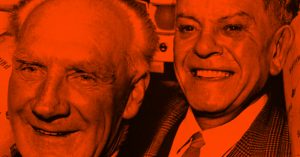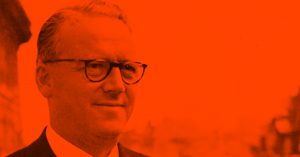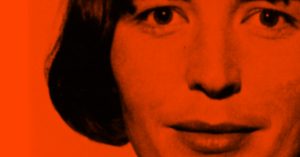‘Just Start A Five-Day TV Service’ They Said!
Lloyd Williams gets the job done

Lloyd Williams, Assistant Controller of Programmes, Associated-Rediffusion, tells how weekday ITV was launched
They said they wanted a television service to operate five days a week, to put out 4 1/2 hours a day; and we said we had better get on with it then, as there wasn’t much time. So on January 3rd 1955, Bill (Roland Gillett, first Controller of Programmes, Associated-Rediffusion, Ltd., later in the Jack Hylton TV Organization) and I sat down with a plain sheet of paper and started reckoning on what we would want to get on the air in the September of the year.Then we reckoned what we would want to stay on the air.

We put the word round among a few old TV chums that we were in business, and one or two of them came to see us – not many at first, only the ones who could smell adventure and the excitement of starting up a new industry.
Cecil (Cecil Lewis, then Deputy Controller of Programmes, Associated Rediffusion, Ltd.) had joined us, and the three of us sat them down in chairs and tried to tell them about our plans. There would be a great chance for those who really wanted to work, to pit their skill against the rest, to forget security and expose their talents in fierce competition and so on. Most of them went out with their heads high and eyes shining; some we sent back to whence they came.
So, after two months, we assessed how many we were likely to get who knew about television, and who might think our way. It wasn’t enough. We would have to train 200 to cover our minimum requirements. Then a High Person rang up and said, “Chum, we want seven hours a day from you – not four-and-a-half.” I said, “That makes things a little difficult”; and he rang off rather quickly.
Training, training, training. How on earth could we train people with nothing to train them with? And so we talked to a lot of people about this and it seemed as if they were all busy, too. Then we met George Kelsey of Marconi’s, and somehow the situation changed. Perhaps they had foreseen the problem. Perhaps they caught some of our enthusiasm. We don’t know – maybe it was a combination of both, but by the beginning of May training was in full swing at a tiny studio in Kensington. Tiny, but how valuable! George made it a priority job, and his engineers fitted this little place out as their own television studios, the first in the country.

In the weeks of hectic preparation before ITV programmes appeared, the Associated-Rediffusion organization in London used a small studio for training. Men and women from the theatre and film worlds, who had never worked in television, were trained in the production of short programmes. Here a training session is testing both trainee producer and aspiring artists for the new commercial service.
Over 2,000 people applied for 200 jobs; and came the interviewing, letter-writing, and the feeling of excitement. Four months before programmes must start we had 160 on the staff, and there came the word to move H.Q. to the former Adastral House in Kingsway. Renamed Television House, it was to be the centre of ITV, with its own studios and modern offices.
And the week before we moved in, the builders moved in, too, with steam shovels, cement mixers and several hundred pneumatic drills: an orchestra that was to provide a non-stop accompaniment to our programme planning that will live with most of us forever. When, with a shattering roar, the blade of the drill appeared through the office wall, we gathered our dust-laden plans and moved to the next office – and so on.
At Wembley, where the old film studios were being rebuilt, deadlines were going by the board, and it seemed as if we would never be able to get away on September 22nd. So to insure against lack of TV studio space at the outset, we started filming in April at Shepperton. New methods of quick filming for television. New treatment of stories, new ideas. A production line of programme product to sustain our air time.
By July 30th the first part of the training scheme had been completed, and now we were to start operational advanced training at the old Granville Theatre, at Walham Green, where conversion for television had been going on for three months. The schedule for training had to be maintained, and everything depended on the Granville being ready. Seventy trainees were ready to move over from Kensington, eager to get into the first operational ITV studio; 70 more were ready to move into Kensington.

We recast the schedule, and advanced training started at the Granville seven days later, but with a difference. Double shifts now: one batch from nine a.m. to four p.m., then the next from five to ten p.m. Meanwhile our Remote (outside broadcast) vans were out around London on dummy runs, setting up a complete outside-broadcast organization.
By August 29th we got into a studio at Wembley and started full-scale programme rehearsals. Only three weeks to go, before we would show ourselves to the public who would judge us side by side with a service that had been operating for 13 years.
Studio directors, lighting men, camera and sound operators, vision mixers and floor managers came straight off the training course to plan their first shows. The first of our sets off the scenery supply line arrived and were hastily stacked in the open with a tarpaulin thrown over. Actors and orchestras, make-up and wardrobe girls, scene men, engineers and production planners moved into Wembley and elbowed indignant builders’ men out.

The morning of September 22nd brought the first of the “good luck” messages that came from all over the world, and with them the realization that a lot of people we had never seen wanted us to do well, and that in the evening the eyes of the world would be on us.
At 7.10 that night we stood in the improvised Control Room in Kingsway and our service went on the air. And no one can know who wasn’t there just how that felt. When we were safely launched we left the room and Bill, the engineer-in-charge (Bill Cheevers, Head of Engineering, Associated-Rediffusion, Ltd.) turned to say something to us and couldn’t say it, and we couldn’t see him very well, anyway, so we turned away and walked along the corridor. It seemed strange that the only noise now was the noise of our service being on the air – but it was good music to us.
Reprinted from The Television Annual for 1957, published by Odhams
About the author
Lloyd Williams was assistant controller of programmes at Associated-Rediffusion



